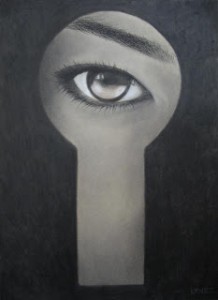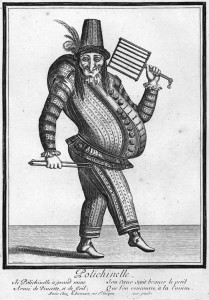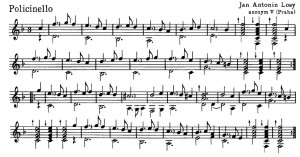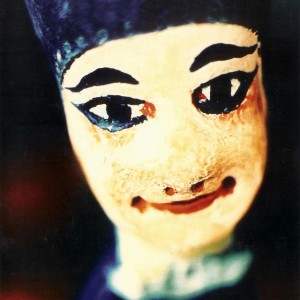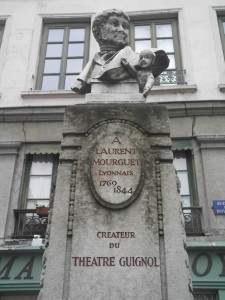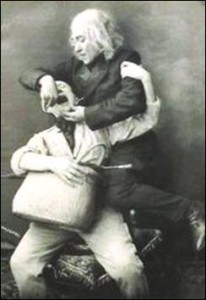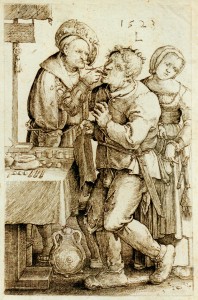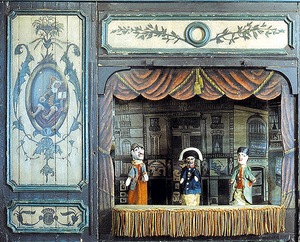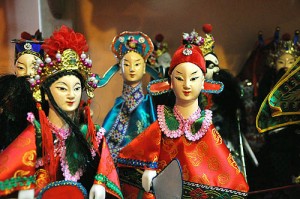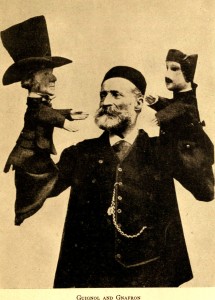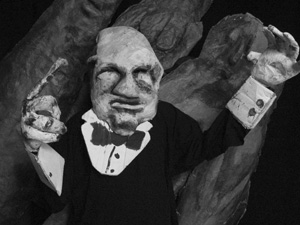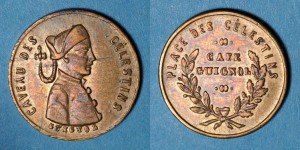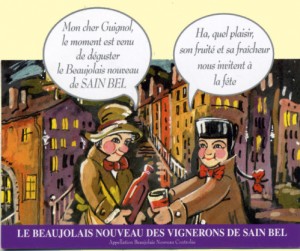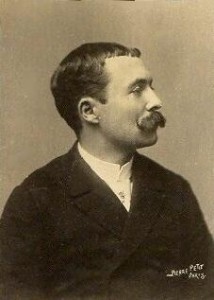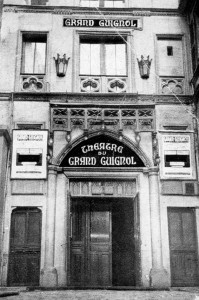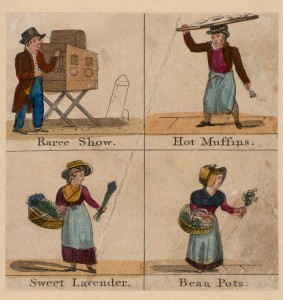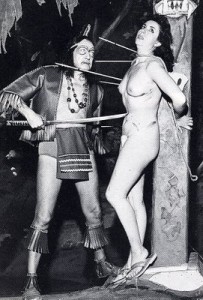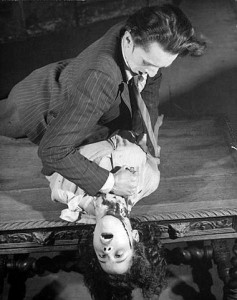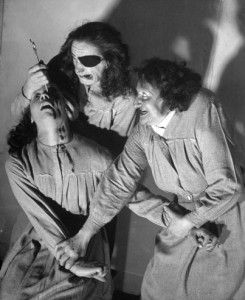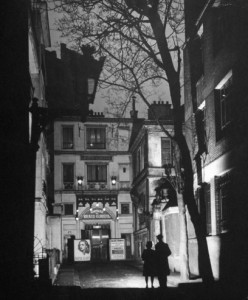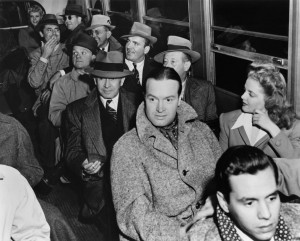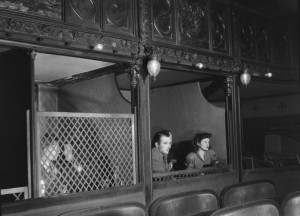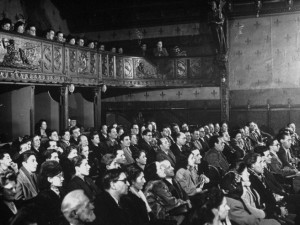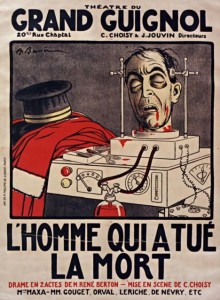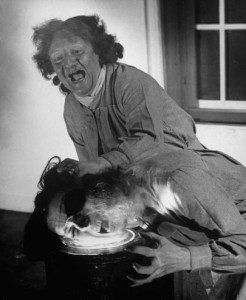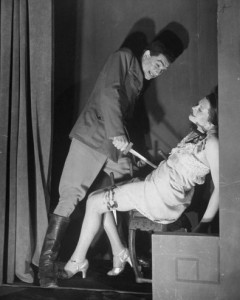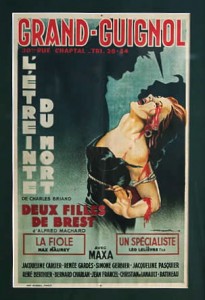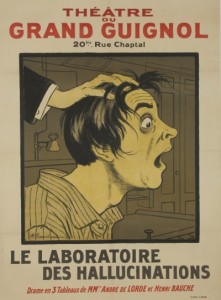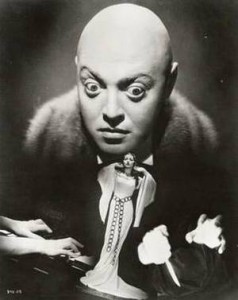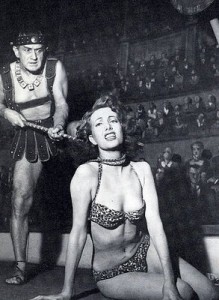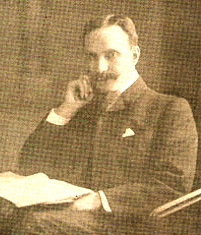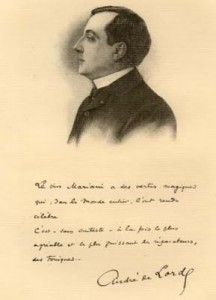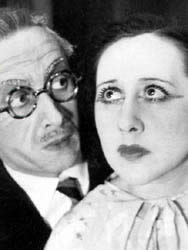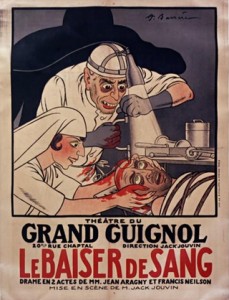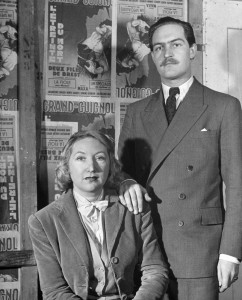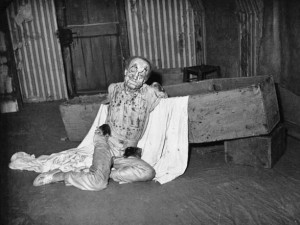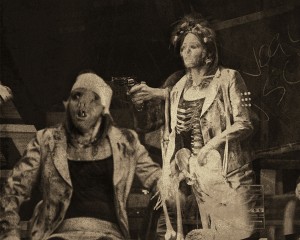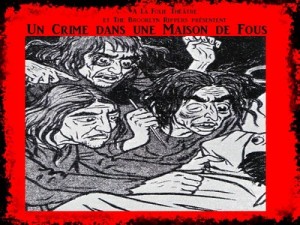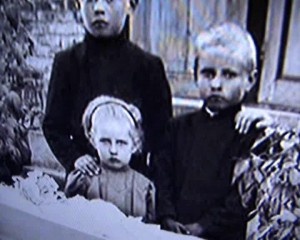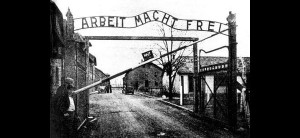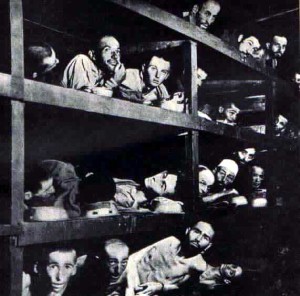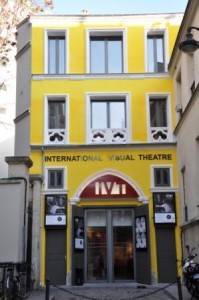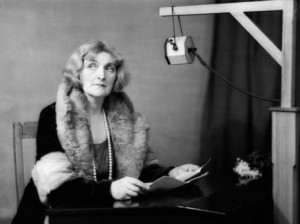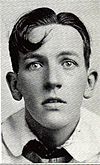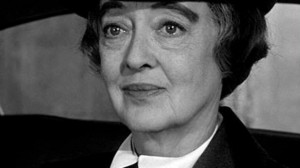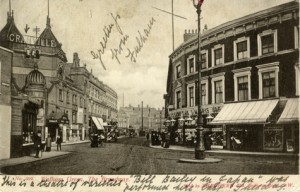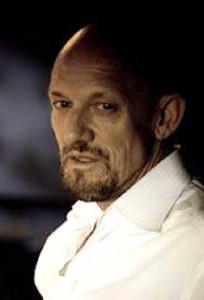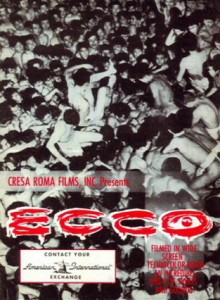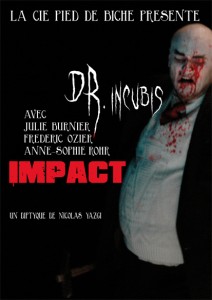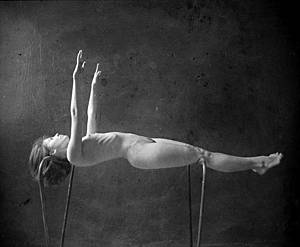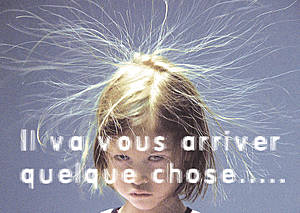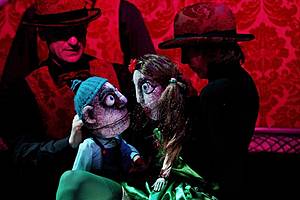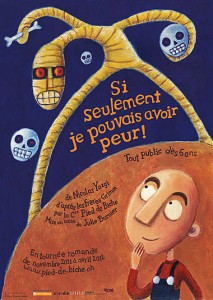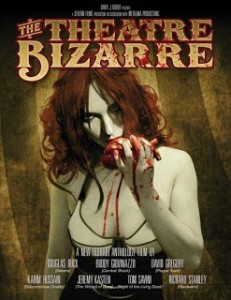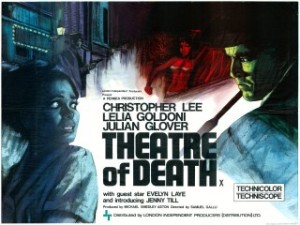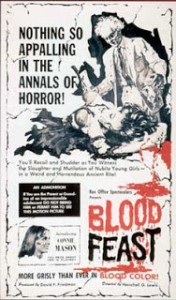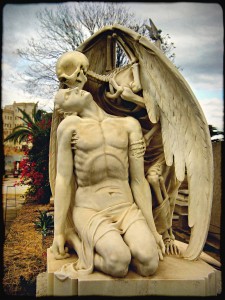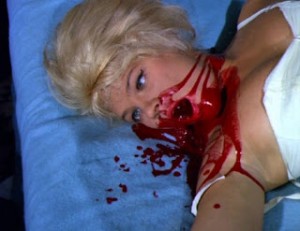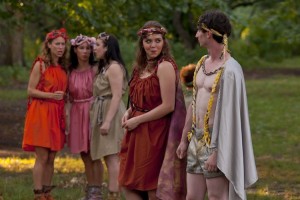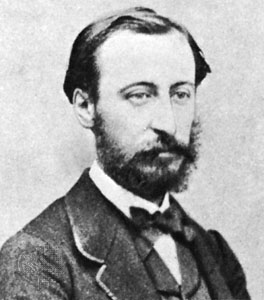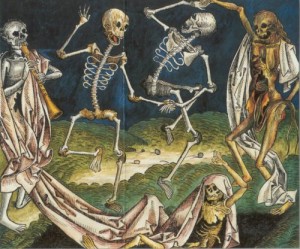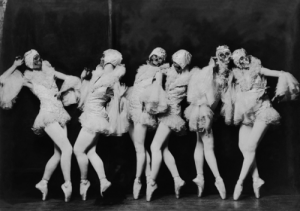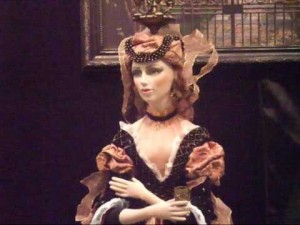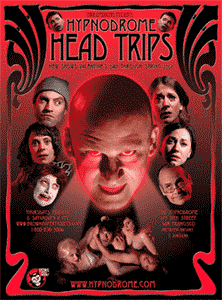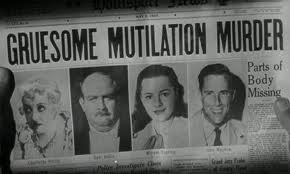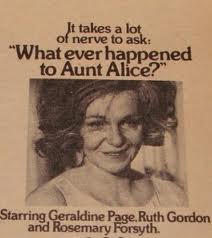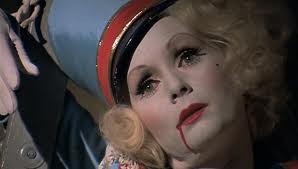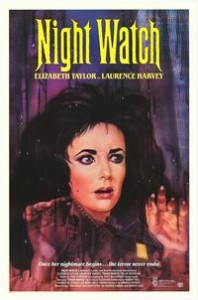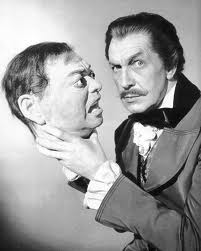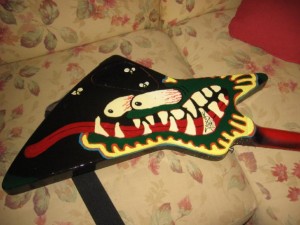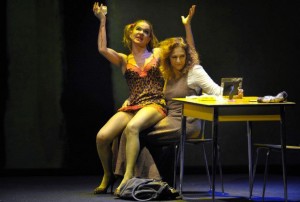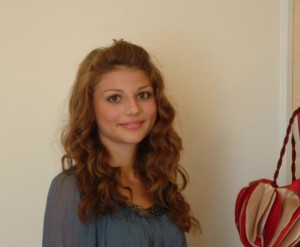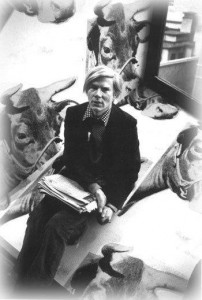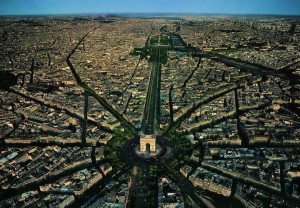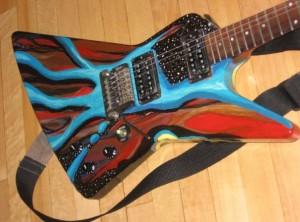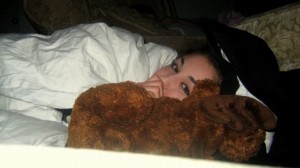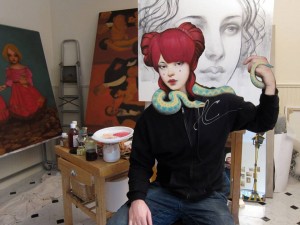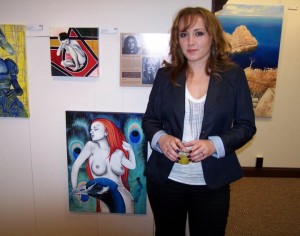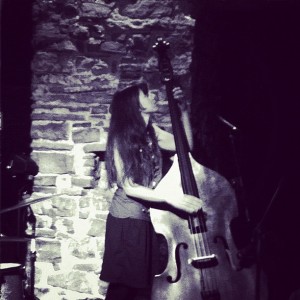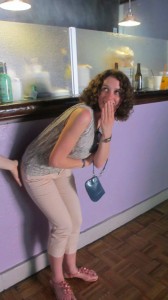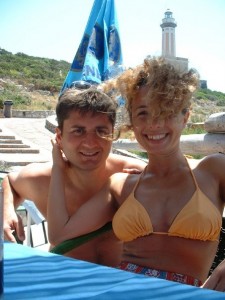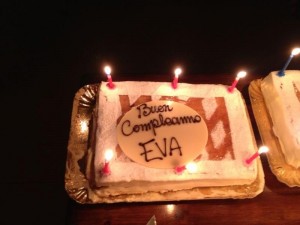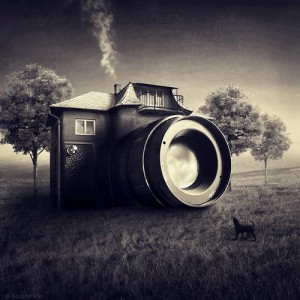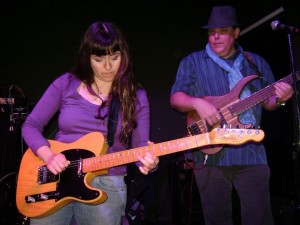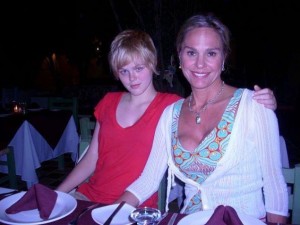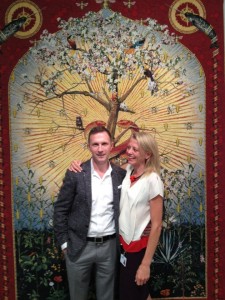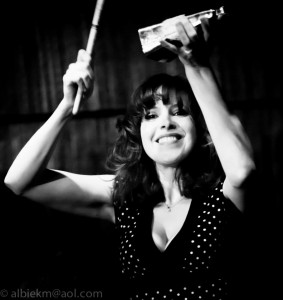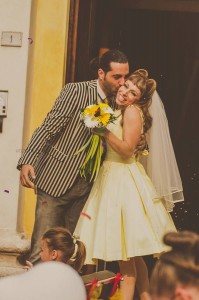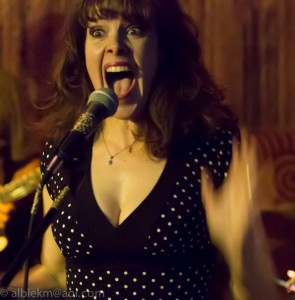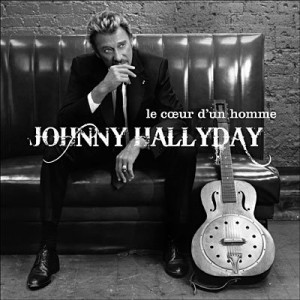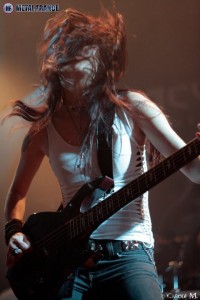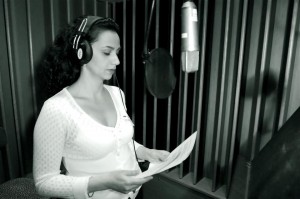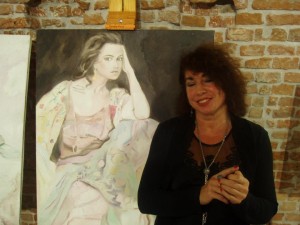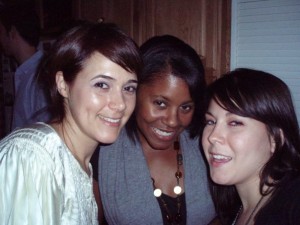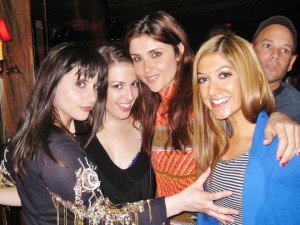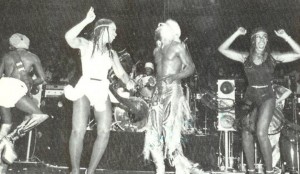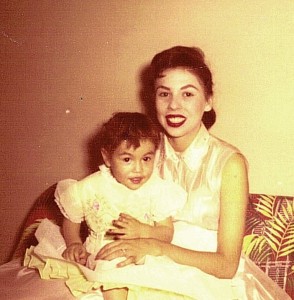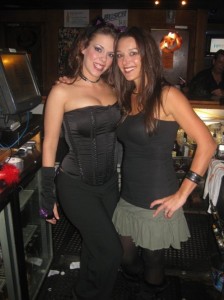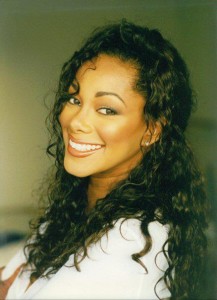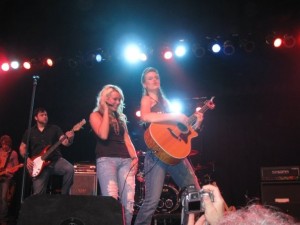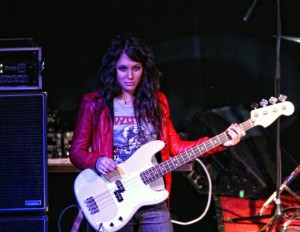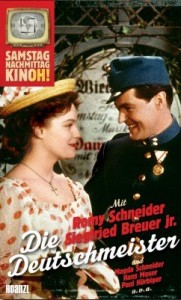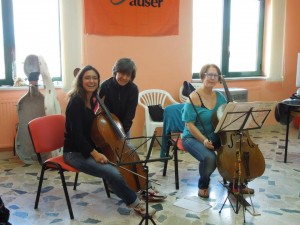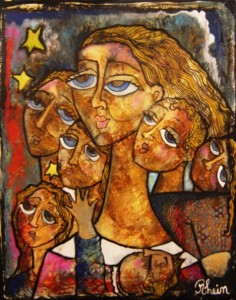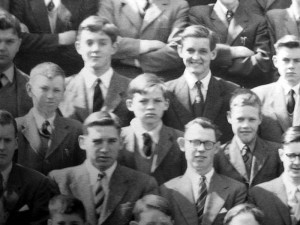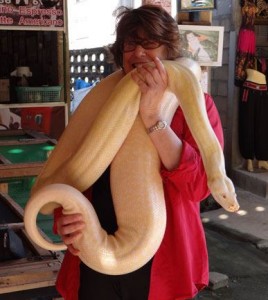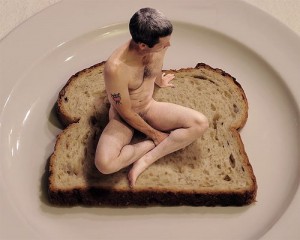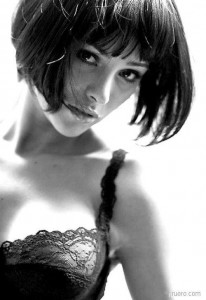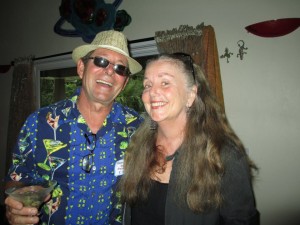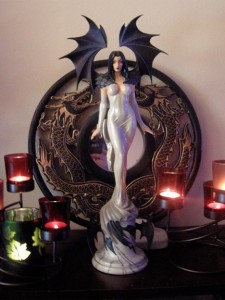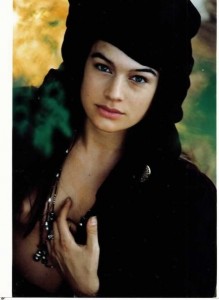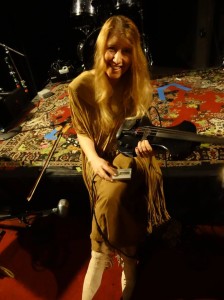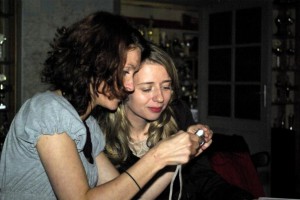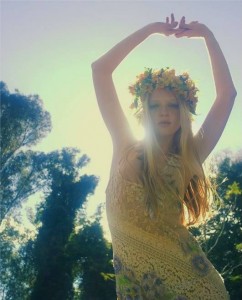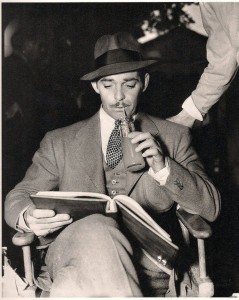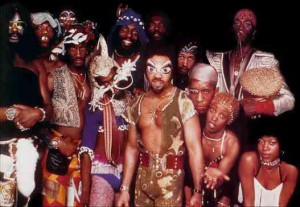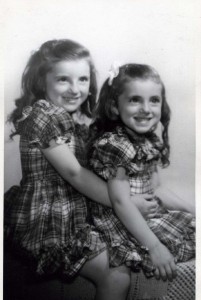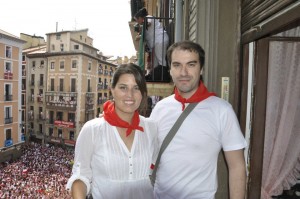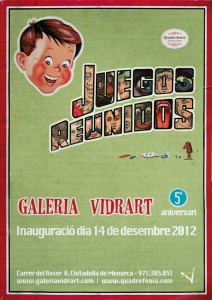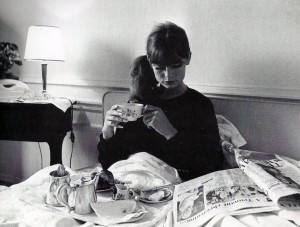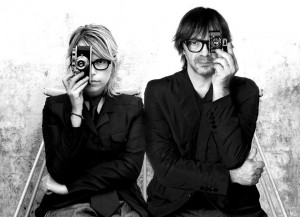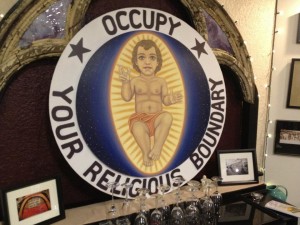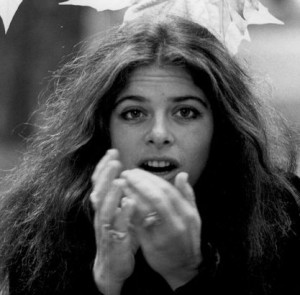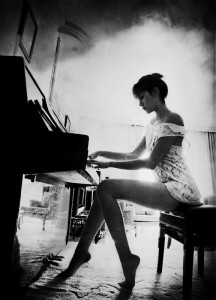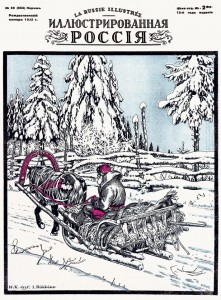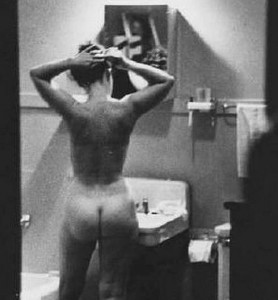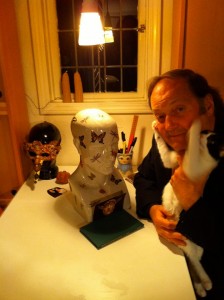Guigner is French for wink, to steal a glance at,
to covet, to peep.
A guignol is one who does these things.
The word also means puppet and more specifically Punch as he is known in English (Policinello, Polichinelle in Italian and French).
The puppet « Guignol » was created by Laurent Mourguet in 1808 and is now the most recognized well known puppet in France.
Laurent Mourguet (1769-1844), was a silk worker in Lyon before the Revolution.
After the war, he decided to change his profession and became a dentist or rather an « arracheur de dents » (« puller of teeth »).
He set up a stall in the market.
In order to attract patients to his stall, he created a simple « castelet » (puppet theatre) and performed scenes using his own hand made « glove» puppets.
Monsieur Mourguet was the first person to pioneer this technique. Up until then, puppets had only been manipulated by strings.
The first characters to appear were Polichinelle and the Devil. At the beginning of the XIXth century he introduced « Gnafron » followed by «Guignol » in 1808.
In 1820, Laurent Mourguet created a traveling puppet troop which toured the Rhône, Loire and Isère.
By 1830, they had perfected their technique and the show became a triumph.
They eventually settled down in Lyon and opened their own Theatre « Le Caveau des Célestins ».
Almost a century later, Le Théâtre du Grand-Guignol (The Theatre of the Big Puppet) was founded in 1894 by Oscar Méténier who planned it as a space for naturalist performance.
With 293 seats, Le Théâtre du Grand-Guignol was the smallest venue in Paris and was located in Pigalle, 20 bis, rue Chaptal.
Le Théâtre du Grand-Guignol owed its name to Guignol and to the Lyonnais Laurent Mourguet who had joined political satire with a puppet show.
From its opening in 1897 until its closing in 1962, Le Théâtre du Grand-Guignol specialized in naturalistic horror shows.
The phrase grand guignol is often used as a general term for graphic, amoral horror entertainment, a genre popular from Elizabethan and Jacobean theatre (for instance Shakespeare’s Titus Andronicus and Webster’s The White Devil) to today’s splatter and snuff films.
And then the term has expanded to describe generally any sensational and horrific event.
The theatre’s peak was between World War I and World War II.
It was often frequented by royalty and celebrities in evening dress.
A former chapel, the theatre’s previous life was evident in the boxes – which looked like confessionals – and in the “angels” over the orchestra.
Although the architecture created frustrating obstacles, this interior design that was initially a problem ultimately became a boon for the marketing of the theatre. The heavy furniture and gothic structures placed here and there on the walls of the building exuded a feeling of eeriness.
People came to this theatre not for a mere show, but for a whole experience and they weren’t disappointed.
The audience at Le Théâtre du Grand-Guignol endured the terror of the shows because they wanted to feel strong emotions of real intensity.
There was definitely a sexual component to the drama.
Underneath the balcony were boxes (originally built for nuns to watch church services) that were available for theatre-goers to rent during performances for whatever purpose.
The audience members would carry on to such an extent in these boxes, that the actors would sometimes break character and yell “keep it down in there!”
On the other hand, there were audience members who could not physically handle the brutality of the actions taking place on stage and would sometimes faint and/or vomit during performances.
Oscar Méténier was the Grand Guignol’s founder and original director. Under his direction, the theater produced plays about a class of people who were not considered appropriate subjects in other venues: prostitutes, criminals, street urchins, and others at the lower end of the Parisian social echelon.
Max Maurey served as director from 1898 to 1914. Maurey shifted the theater’s emphasis to the horror plays it would become famous for and judged the success of a performance by the number of patrons who passed out from shock; the average was two faintings each evening.
Maurey discovered André de Lorde who would become the most important playwright for the theatre and was the theater’s principal playwright from 1901 to 1926. He wrote at least 100 plays for the Grand Guignol and collaborated with experimental psychologist Alfred Binet to create plays about insanity, one of the theater’s frequently recurring themes.
Camille Choisy served as director from 1914 to 1930. He contributed his expertise in special effects and scenery to the theater’s distinctive style.
Paula Maxa was one of the Grand Guignol’s best-known performers. From 1917 to the 1930s, she performed most frequently as a victim and was known as “the most assassinated woman in the world”. During her career at the Grand Guignol, Maxa’s characters were murdered more than 10,000 times in at least 60 different ways and raped at least 3,000 times.
Jack Jouvin served as director from 1930 to 1937. He shifted the theater’s subject matter, focusing performances not on gory horror but psychological drama. Under his leadership the theater’s popularity waned; and after World War II it was not well-attended.
Charles Nonon was the theater’s last director.
At the Grand Guignol, patrons would see five or six plays, all in a style that attempted to be brutally true to the theatre’s naturalistic ideals.
The plays were in a variety of styles, but the most popular and best known were the horror plays, featuring a distinctly bleak worldview as well as notably gory special effects in their notoriously bloody climaxes.
These plays often explored the altered states, like insanity, hypnosis, panic, under which uncontrolled horror could happen. Some of the horror came from the nature of the crimes shown, which often had very little reason behind them and in which the evildoers were rarely punished or defeated. To heighten the effect, the horror plays were often alternated with comedies in order to, if you will, cleanse the palate between courses.
Le Laboratoire des Hallucinations, by André de Lorde: When a doctor finds his wife’s lover in his operating room, he performs a graphic brain surgery rendering the adulterer a hallucinating semi-zombie. Now insane, the lover/patient hammers a chisel into the doctor’s brain.
Un Crime dans une Maison de Fous, by André de Lorde: Two jealous hags in an insane asylum use scissors to blind a young, pretty fellow inmate.
L’Horrible Passion, also by André de Lorde: A nanny strangles the children in her care.
Le Baiser dans la nuit by Maurice Level: A young woman visits the man whose face she horribly disfigured with acid, and he obtains his revenge.
Audiences waned in the years following World War II, and the Grand Guignol closed its doors in 1962, the year that I went to live in Paris. Management attributed the closure in part to the fact that the theater’s faux horrors had been eclipsed by the actual events of the Holocaust two decades earlier.
“We could never equal Buchenwald,” said its final director, Charles Nonon. “Before the war, everyone felt that what was happening onstage was impossible. Now we know that these things, and worse, are possible in reality.”
The Grand Guignol building still exists. It is occupied by International Visual Theatre, a company devoted to presenting plays in sign language.
Grand Guignol flourished briefly in London in the early 1920s under the direction of Jose Levy, where it attracted the talents of Sybil Thorndyke and Noël Coward.
A series of short English “Grand Guignol” films (using original screenplays, not play adaptations) was made at the same time, directed by Fred Paul.
The Grand Guignol was revived once again in London in 1945, under the direction of Frederick Witney, where it ran for two seasons at the Granville Theatre. These included premiers of Witney’s own work as well as adaptations of French originals.
In recent years, English director-writer, Richard Mazda, has re-introduced New York audiences to the Grand Guignol. His acting troupe, The Queens Players, have produced 6 mainstage productions of Grand Guignol plays, and Mazda is writing new plays in the classic Guignol style.
The sixth production, Theatre of Fear, included De Lorde’s famous adaptation of Poe’s Le Système du Dr Goudron et Pr Plume (The System of Doctor Tarr and Professor Feather) as well as two original plays, Double Crossed and The Good Death with The Tell Tale Heart.
The 1963 mondo film Ecco includes a scene which may have been filmed at the Grand Guignol theatre during its final years.
American avant-garde composer John Zorn released an album called Grand Guignol by Naked City in 1992, a reference to “the darker side of our existence which has always been with us and always will be”.
The Washington, D.C.-based Molotov Theatre Group, established in 2007, is dedicated to preserving and exploring the aesthetic of the Grand Guignol. They have entered two plays into the Capital Fringe Festival in Washington, D.C. Their 2007 show, For Boston, won “Best Comedy”, and their second show, The Sticking Place, won “Best Overall” in 2008.
The Swiss theatre company, Compagnie Pied de Biche revisits the Grand Guignol genre in contemporary contexts since 2008.
The company staged in 2010 a diptych Impact & Dr. Incubis, based on original texts by Nicolas Yazgi and directed by Frédéric Ozier.
More than literal adaptations, the plays address violence, death, crime and fear in contemporary contexts, while revisiting many tropes of the original Grand Guignol corpus, often with humor.
La Compagnie Pied de Biche defends the idea that theatre is nowadays the best space for audiences to experience genuine fears. As movies have overdone their explorations of the representation of violence, the intimate space of a theatre where actors hurt themselves and each other, at times with extra help from the theatrical illusion, might become again the most genuine stage of fears.
The company also staged in 2011–12, Si seulement je pouvais avoir peur (If only I could be afraid) a production directed by Julie Burnier of a text by Nicolas Yazgi inspired by the Brothers Grimm. The play addresses the themes of death, rejection, fear and violence for youth audiences.
Set in a burlesque expressionist stage design, ghoulish puppets unveil the fate of a young boy who isn’t able to feel fear, because he hasn’t realized what death is.
The recently formed London-based Grand Guignol company Theatre of the Damned, brought their first production to the Camden Fringe in 2010 and produced the award nominated Grand Guignol in November of that year.
On May 2, 2011, they announced their new production “Revenge of the Grand Guignol”, which is to be staged in London from October 25 at the Courtyard Theatre, London, as part of the London Horror Festival.
Also based in London, Le Nouveau Guignol form the UK’s only permanent reperatory Grand Guignol company.
Plays within their current repertoire include French Guignol classics such as “The Final Kiss”, “Tics… Or Doing the Deed”, “The Lighthouse Keepers”, “Private Room Number Six” and “The Kiss of Blood”.
Le Nouveau Guignol also encourages new writing, staging several new plays in the Grand-Guignol style, including “Eating For Two”, “Penalty” and “Ways and Means”.
The Xoregos Performing Company presents Danse Macabre, a contemporary tribute to Grand Guignol at Theater for the New City in New York City. Danse Macabre is a program of four plays of psychological and physical terror and two humorous works, in keeping with Grand Guignol’s programming history.
The playwrights are Dave DeChristopher, Jack Feldstein, Dylan Guy, Pamela Scott and Joel Trinidad.
A dance to the famous orchestral score by Camille Saint-Saëns will be performed by the actors.
There will be six performances between August 18-30, 2013 in the Dream Up Festival at Theater for the New City, Manhattan.
The Japanese music group ALI Project created the song “Gesshoku Grand Guignol” as the opening for the Bee-Train anime Avenger, while British rock band Duels also named an instrumental track after the theatre.
While the original Grand Guignol attempted to present naturalistic horror, the performances would seem melodramatic and heightened to today’s audience. For this reason, the term is often applied to films and plays of a stylised nature with heightened acting, melodrama and theatrical effects such as
What Ever Happened to Baby Jane?
Hush, Hush, Sweet Charlotte.
What Ever Happened To Aunt Alice?
What’s The Matter With Helen?
Night Watch
These films form a sub branch of the genre called Grande Dame Guignol because of its use of aging A-list women actors in sensational horror films. On the male side, Vincent Price was the king of grand guignol américain.
And now, a gallery of contemporary grand guignol themes:
Les Pantins du Vice Puppets of vice
Ce qu’on lit sur les routes.
La perception extérieure
Définition de la psychologie
Nouvelles recherches sur les mouvements graphiques
Instruction pour étudier la double conscience chez les hystériques
L’obsession ou les deux forces
Le Cerveau d’un Imbécile
Une Leçon à la Salpêtrière
L’Horrible expérience
I am an artist. That doesn’t mean that I work for free. I have bills to pay too. Thank you for understanding.
L’homme mystériux
Les Invisibles
La Maison de la mort
Crime dans une maison de fous
L’Homme étrange
Le grand mystère
Napoléon III
L’homme qui a tué la mort
Gott mit uns (god with us)
La Cathédrale Engloutie
Louange à l’éternité
Elle
La Dernière Torture
Gardiens de phare
La Veuve
Après coup
Sous la lumière rouge
Le baiser dans la nuit
Le Jardin des supplices
Le Baiser du sang
Le Laboratoire des hallucinations
Le Système du Dr Goudron et Pr Plume
Un Crime dans une maison de fous
Monsieur, Madame et… les autres
Une bonne farce
Dans la nuit
Madame Blanchard
Loreau est acquitté
Rêves d’un soir
L’Affaire Boreau
La Lettre
La Dormeuse
Doux espoirs
Hermence de la vertu
Au téléphone
La Jeune
Attaque nocturne
L’Idiot
Madame Hercule
La Nuit rouge
La Victime, ou l’Affaire de l’impasse des Trois-Poulets
Baratrie
À qui le tour?
Terre d’épouvante
Cordon sanitaire
Un concert chez les fous
L’Innocent
Sur la dalle
Bagnes d’enfants
Figure de cire
Le coeur de Floria
La Petite Roque
Sous les marroniers
L’Amour en cage
Ernestine est enragée.
Le Truc d’Adolphe
La Folie au Théâtre
La Maffia
La Visiteuse
Le Château de l’amour lente
La Bonne amie
L’Enfant mort
Napoléonette
Forfaiture
L’Homme de la nuit
Un beau tableau
Mon p’tit Tom
Le Cerceuil de chair
L’Homme aux chèques
Le Feu de joie
Mon curé chez les riches
Le Cabinet du Docteur Caliguri, ou bien Caligari, comme tu veux
L’Étrangleuse
Les Nuits rouges de la Tchéka
La Chambre ardente
Une nuit d’Edgar Poe
Mon curé chez les pauvres
Dans les dunes
Le Roman d’une femme de chambre
Jack l’éventreur
Magie noire
Pour jouer la comédie de salon
Cauchemars
Rosette, ou l’Amoureuse conspiration
Les Maîtres de la peur
L’Étrange amant du mal
La Galerie des monstres
Le Second crime de la dame en noir
Dernière conquète
Contes du Grand-Guignol
La Villa solitaire
La Courroie
À la prochaine…
Goodbye till next week, and thank you for reading.
Sam Andrew
___________________________________________

